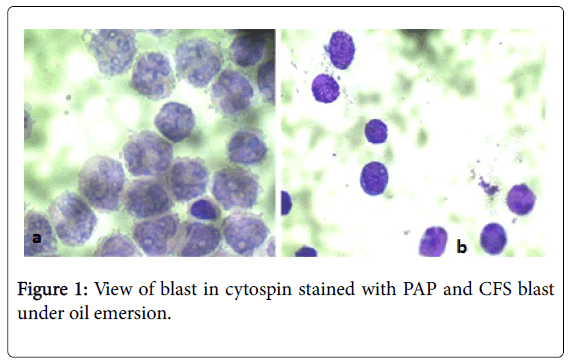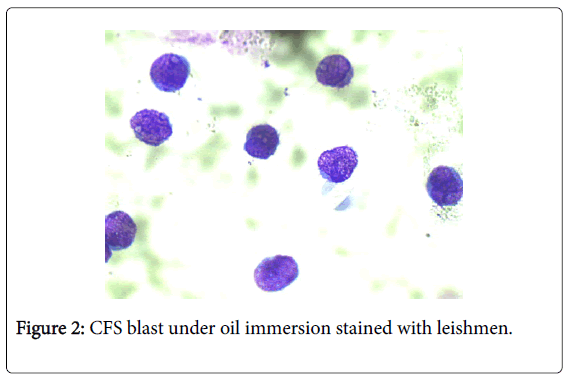Relapse in Chronic Myeloid Leukemia with Central Nervous System Blast Crisis ��? Case Studies
Received: 19-Sep-2016 / Accepted Date: 07-Nov-2016 / Published Date: 11-Nov-2016 DOI: 10.4172/2161-0681.1000298
Abstract
Chronic myeloid leukaemia is a tri phasic disease characterized by the presence of Philadelphia chromosome and/or molecular evidence of BCR/ABL hybrid gene in the hematopoietic cells. Natural course of disease has a chronic phase followed by an accelerated phase and finally leukemic phase or blast crisis. Extra medullary manifestation is rare and the sites commonly involved are skin, soft tissue, lymph node, GIT. However CNS as a site of extra medullary blast crisis is rare. Imatinib meyslate is a potent and selective inhibitor of BCR-ABL tyrosine kinase. However there is poor penetration of CNS by the drug and its metabolites. Therefore the CNS acts as a sanctuary site for malignant cells for CML. We report four cases of CML who relapsed with CNS involvement after passing from chronic to blastic/lukemic phase.
Keywords: Chronic myeloid leukemia; Central nervous system; Cerebral spinal fluid; Blast crisis; Chromosome; Tyrosine; Apoptosis
315151Abbreviations
CML: Chronic Myeloid Leukemia; CNS: Central Nervous System; CSF: Cerebral Spinal Fluid; MRI: Magnetic Resonance Imaging
Introduction
Chronic myeloid leukaemia is unregulated growth of myeloid cells in bone marrow. It is characterized by reciprocal exchange of genetic material between chromosome 9 and 22, with the formation of new gene BCR-ABL a protoncogene which increases cellular proliferation, and decreased apoptosis or both [1].
Since 2000, antimetabolite and alkylating agents has been largely replaced by BCR-ABL tyrosine kinase inhibitor drugs like Imatinib mesylate and Dasatinib. Imatinib binds to ATP binding site of BCRABL oncoprotein and prevents transfer of phosphate from ATP to second messenger [1]. Thus Tyrosine kinase drugs are effective in Chronic to blastic phase of hematological phase of disease [2]. However as these drug do not penetrate blood brain barrier it could be the cause of low levels of drug in the CNS and the cause of CNS relapse [3,4].
Case Presentation
Four cases of CML are presented who relapsed with CNS blast crisis (Table 1).
| Case One | Case Two | Case Three | Case Four | ||
|---|---|---|---|---|---|
| 15 years female patient presented with the complaint of fever, headache. Diagnosed CMLin June 2013 went in blast crisis in Dec 2013 and again in Sept 2014 underwent treatment with imatinib and was in remission. | 28 year female patient presented with the complaint of headache, blurring of vision.Patient was diagnosed with CML in 2009 was given Imatinib and was in remission underwent marrow transplant in 2014. | 46 year male patientpresented with the complaint of fever, headache for four days and blurring of vision 2 days. He was diagnosed as CML in June2013 was treated with Imatinib went in blast crisis in December13 and was in remission after combined therapy.Bone marrow transplant was done in May 2014. | 21 year male patient presented with the complaint of headache for 15 days was diagnosedCML in 2009 treated with Imatinib,went in blastic phase in 2013 underwent bone marrow transplantin Feb 2014 after being in remission for a year. | ||
| Cardiovascular and respiratory system examination did not revealed any abnormality and abdomen was soft without any hepatosplenomegaly. | Cardiovascular and respiratory system examination did not reveal any abnormality and abdomen examination showed hepatosplenomegaly. | On clinical examination Cardiovascular and respiratory systemnot revealed any abnormalityand abdomen was softwithout any hepatosplenomegaly. | Cardiovascular and respiratory system examination did not reveal any abnormality and abdomen was soft without any hepatosplenomegaly. | ||
| Central nervous system examination showed neck rigidity, bilateral planters were in flexion. Higher mental functions were normal. | Central nervous system examination showed neck rigidity, bilateral planters were in flexion.Higher mental functions were normal. | CBC examination was found to have normocytic normochromic anemia with Hb 0f 9.9gm/dl, normal total leukocyte of 6,800/cu mm and normal platelets count of 2,23000/cu mm.There were no abnormal cells in the peripheral blood.Bone marrow examination was normal with no abnormal cells. | CBC examination was found to have normocytic normochromic anemia withHb10.4gm/dl, total leukocyte of 6900/cu mm and platelets count of 15, 000/cu mm.There were no abnormal cells in smear. | ||
| Lumber puncture was done to examine CSF, which showeda clear fluid with negative bacterial culture. Total cell count of fluid was high 2,900 cells/cu mm and showed presence of atypical cells (15%) with high nuclear –cytoplasmic ratio, irregular nuclear contours and prominent nucleoli. (Figures 1 and 2). | Lumber puncture was done to examine CSF, which showeda clear fluid with negative bacterial and AFB culture. Total cell count of fluid was 400 cells /cu mm and showed presence of plenty of atypical cells with high nuclear –cytoplasmic ratio and prominent nucleoli (Figures 1 and 2). The protein content of fluid was106.3mg/dl with sugar 27mg/dl and normal chloride level 119meq/l. | Lumber puncture was done to examine CSF, which showed a clear fluid with negative bacterial culture.Total cell count of fluid was 384 cells /cu mm high and showed presence of atypical cells (40%) with high nuclear-cytoplasmic ratio and prominent nucleoli (Figure 2). The protein content of fluid was 52.1 mg/dl with sugar 37gm/dl and normal chloride level 118 meq/l. | Lumber puncture was done to examine CSF, which showeda clear fluid with negative bacterial culture.Total cell count of fluid was high 700/cu mm and showed presence of atypical cells (47%) with high nuclear-cytoplasmic ratio and prominent nucleoli and many mitotic figures (Figures 1 and 2). The protein content of fluid was 43 mg/dl with level of sugar 33mg/dl and normal chloride level 127 meq/l. | ||
| Fundoscopy shows papilledema. MRI revealed diffuse mild cerebral and cerebellar atrophy and mild communicating hydrocephalus. | Fundoscopy shows papilledema.MRI finding showed hyper intensity in midbrain, pons, and bilateral hemisphere and diffuse leptomeningeal enhancement in bilateral cerebral hemisphere. | MRI of brain was normal, while fundoscopy showed small retinal hemorrhage. | MRI showed Leptomeningeal and patchy meningeal enhancement in right frontal and parietal lobe. | ||
| Mode of Treatment | |||||
| Patient was treated with imatinib. | Patient was treated with imatinib and underwent marrow transplant. | Patient was treated with imatinib and hydroxyurea. Later underwent marrow transplant. | Patient was treated with imatinib and underwent marrow transplant. | ||
| Flow Cytometry Data | |||||
| Flow Cytometryanalysis of fluid verified the presence of blast with presence lymphoid blast(showing positivity for CD 19,22,34 and 10 confirming lymphoid blast). | Flow cytometry confirmed presence of lymphoid blast, the total blast count percentage was 40% and B cell marker CD19,22, 10 and 34 was positive. | Flow cytometry report confirmed the presence of myeloid blast showing positivity with CD 33,13,34 and 45. | Flow cytometry confirmed the presence of lymphoid blast with positivity for CD19,20, 10,22,34 and HLADR. | ||
Table 1: Four cases of chronic myeloid leukemia and their relapse with the CNS blast crisis.
Discussion
BCR-ABL transcript is regarded as early markers for a hematological relapse of CML [5]. Oral tyrosine kinase inhibitor such as Imatinib shows activity in CML patient in the accelerated phase and or blast crisis, however several studies has shown that the penetration of the drug and its metabolites into the CNS is poor (Figure 1).
Wolff et al. studied the effect of chronic treatments with Imatinib at therapeutic dose in mice reconstituted with BCR-ABL transduced bone marrow. They found that though Imatinib excellently controlled the CML like illness but many of the mice unexpectedly developed progressive neurological deficits due to leukemic cell infiltration of meninges and brain [6,7].
For the study, over a span of one year 15 CML cases were reported in the hospital out of which 5 were in blast crisis and later four of these cases relapsed with CNS involvement (three cases had lymphoid blast while one had myeloid blast). Keeping this into consideration, patient with hematological blastic phase should have same module of investigation as in acute leukemia cases and should undergo lumber puncture examination at regular interval as done in acute leukemia cases (Figure 2).
Conclusion
Patient of CML who subsequently goes in Blast crisis phase should undergo lumber puncture and CSF examination at regular interval regardless of type of blast (myeloid or lymphoid) with analysis of BCRABL in the CSF for reliable detection of isolated relapse or as first sign of a consecutive hematological relapse of CML [8].
References
- Wintrobe’s Clinical Hematology, Thirteen Edition, John P. Greer, Daniel A Arber, BertilGlader, Alan F. List, Robert T. Means Jr. FrixosParaskevas, George M. Rodgers
- Thavaraj V, Seth R(2008) Prophylaxis of central nervous system leukemia: a case of chronic myeloid leukemia with lymphoid blast crisis treated with Imatinibmesylate. World J Pediatr 4: 145–147.
- Bornhauser M, Jenke A, Ritcher JF, Radke J, Schuler US, et al. (2004) CNS blast crisis of chronic myelogenousleukemia in a patient with a major cytogenetic response in bone marrow associated with low levels of Imatinibmesylate and its N-desmethylated metabolite in cerebral spinal fluid. Ann Hematol83:401-402.
- Oshima K, Kanda Y, Yamashita T, Takahashi S, Mori T, et al. (2008) Central nervous system relapse of leukemia after allogeneic hematopoietic stem cell transplantation. Biol Blood Marrow Transplant 14: 1100-1107.
- Chronic Myeloid leukemia (2011) Juan Roasi and Akermans’s Surgical Pathology. pp: 1829.
- Wolff NC, Richardson JA, Egorin M, Ilaria RL Jr (2003) The CNS is a sanctuary for leukemic cells in mice receiving imatinibmesylate for Bcr/Abl-induced leukemia.Blood 101:5010-5013.
- Alintas A, Cil T, Kilnic I, Kaplan MA, Ayyildiz O(2007) Central nervous system blastic crisis in chronic myeloid leukemia on Imatinibmesylate: a case report. J Neurooncol 84: 103-105.
- Fuchs M, Reinhöfer M, Ragoschke-Schumm A, Sayer HG, Böer K, et al. (2012) Isolated central nervous system relapse of chronic myeloid leukemia after allogeneic hematopoietic stem cell transplantation. BMC Blood Disord 12: 9.
Citation: Lata U, Jyoti MJ, Sharat D, Chandrashekhar B (2016) Relapse in Chronic Myeloid Leukemia with Central Nervous System Blast Crisis – Case Studies. J Clin Exp Pathol 6:298. DOI: 10.4172/2161-0681.1000298
Copyright: © 2016 Lata U, et al. This is an open-access article distributed under the terms of the Creative Commons Attribution License, which permits unrestricted use, distribution, and reproduction in any medium, provided the original author and source are credited.
Select your language of interest to view the total content in your interested language
Share This Article
Recommended Journals
Open Access Journals
Article Tools
Article Usage
- Total views: 5135
- [From(publication date): 0-2016 - Jun 30, 2025]
- Breakdown by view type
- HTML page views: 4172
- PDF downloads: 963


